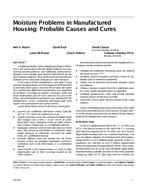Description
A significant number of new manufactured houses built to HUD code and located in the hot, humid Southeast are experiencing moisture problems. Soft wallboards, buckled floors, damaged wood molding, and extensive mold growth are the most common symptoms. These problems do not respond to the standard service and repair strategies for water intrusion. At the request of four manufacturers, more than 25 such moisture-damaged homes were investigated in 1999 and 2000 to determine likely causes. One-time blower door, duct tightness, and pressure differential measurements were performed on all homes. Field data on ambient, crawlspace, belly, and house temperatures and RH were collected on a few of the homes. Recommendations and reports were prepared for the manufacturers’ service, production, and design staff. Field repairs were performed in most of these homes. A generalized theme existed in the houses investigated.
- Lowered air conditioner thermostat setting (typically 68….F to 73….F) below the ambient dew point.
- Negative pressures across the envelope from high supply duct leakage (cfm @25Pa > 10 per 100 ft 2 of conditioned floor area), inadequate return air paths, interior door closures, exhaust fans, or a combination thereof.
- Inadequate moisture removal from disconnected return ducts, fans always on (air handler or ventilation), inadequate drainage of condensate, oversized air conditioner, or a combination thereof.
- Moisture diffusion from the ground into the house because of poor site drainage, inadequate crawlspace ventilation, tears in the belly board, or a combination thereof.
- Vapor retarder in the wrong location, i.e., vinyl or other impermeable wall or floor coverings located on the colder surfaces.
Recommended solutions provided to the manufacturers to eliminate moisture problems include:
- Maintain air-conditioner thermostat above the ambient dew point (at least 75….F).
- Eliminate long-term negative pressures created by air-handler fans or ventilation equipment.
- Tightly seal all ductwork and provide adequate return air pathways.
- Enhance moisture removal from the conditioned space by correct sizing and maintenance of equipment.
- Eliminate ground-source water and provide adequate moisture barrier for the floor assembly.
- If possible, remove vapor barriers located on the wrong surfaces.
Work is continuing to determine if these steps will be sufficient to prevent problems even in the presence of vapor barriers in the wrong locations for the hot, humid climates that are preferred by manufacturers and customers.
Authors: Neil A. Moyer, David Beal, David Chasar, Janet McIlvaine, Chuck Withers, Subrato Chandra, Ph.D.
Citation: Indoor Air Quality 2001 Moisture, Microbes, and Heath Effects: Indoor Air Quality and Moisture in Buildings Conference Papers
Keywords: November, California, 2001, IAQ
Citation: IAQ Conference: IAQ 2001
Product Details
- Published:
- 2001
- File Size:
- 1 file , 1.4 MB
- Product Code(s):
- D-8179




